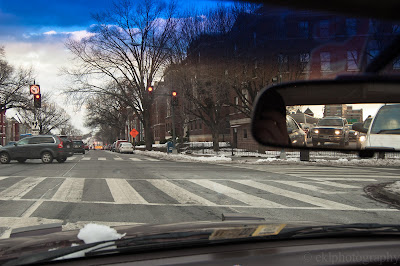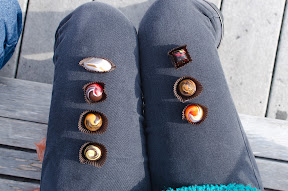Here's a selection of photos from things done in the days betwixt holidays this last month. Some crafty stuff, some baking stuff, some decorations... A decently festive month, indeed.
Saturday, December 24, 2011
Monday, December 19, 2011
Quotations: Calvino
n the shop window you have promptly identified the cover with the title you were looking for. Following this visual trail, you have forced your way through the shop past the thick barricade of Books You Haven't Read, which were frowning at you from the tables and shelves, trying to cow you. But you know you must never allow yourself to be awed, that among them there extend for acres and acres the Books You Needn't Read, the Books Made For Purposes Other Than Reading, Books Read Even Before You Open Them Since They Belong To The Category Of Books Read Before Being Written. And thus you pass the outer girdle of ramparts, but then you are attacked by the infantry of the Books That If You Had More Than One Life You Would Certainly Also Read But Unfortunately Your Days Are Numbered, with a rapid maneuver you bypass them and move into the phalanxes of the Books You Mean To Read But There Are Others You Must Read First, the Books Too Expensive Now And You'll Wait Till They're Remaindered, the Books ditto When They Come Out In Paperback, Books You Can Borrow From Somebody, Books That Everybody's Read So It's As If You Had Read Them, Too. Eluding these assaults, you come up beneath the towers of the fortress where other troops are holding out:
the Books You've Been Planning To Read For Ages,the Books You've Been Hunting For Years Without Success,the Books Dealing With Something You're Working On At The Moment,the Books You Want To Own So They'll Be Handy Just In Case,the Books You Could Put Aside Maybe To Read This Summer,the Books You Need To Go With Other Books On Your Shelves,the Books That Fill You With Sudden, Inexplicable Curiosity, Not Easily Justified.Now you have been able to reduce the countless embattled troops to an array that is, to be sure, very large, but still calculable in a finite number; but this relative relief is then undermined by the ambush of the Books Read Long Ago Which It's Now Time To Reread and the Books You've Always Pretended To Have Read And Now It's Time To Sit Down And Really Read Them...
From If on a Winter's Night a Traveller, by Italo Calvino. Wonderful book, you should go read it.
Tags:
authors,
blogcheating,
books,
bookstores,
literature,
philosophy,
quotations
Saturday, December 10, 2011
Books read in Chincoteague (7 of 7): The Cabinet of Curiosities
ast but certainly not least we have a book acquired from one Jeff VanderMeer, signed by said editor and his accomplice, Ann VanderMeer, and kindly shipped to me for review purposes an embarrassingly long time ago. As is appropriate to such an anthology of bits and pieces, I read The Thackery T. Lambshead Cabinet of Curiosities in fits and starts, probably beginning by the pool last summer, the majority read at Chincoteague, and finished post-move in the new house. On the other hand, it's a rich and complex enough world to sink into, if one tends towards more efficient, focused reading.
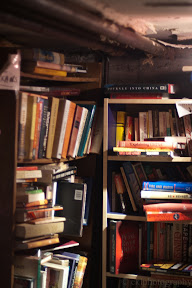 This level of complexity largely stems from the wide array of contributors to this steampunk confluence, including Garth Nix, Tad Williams, Cherie Priest (of Boneshaker) and Alan Moore. While there were amusing oddities described in brief at various points in the book, the short stories have continued to stand out in my mind. The Relic, a story of a sand-bound church and its odd holy item, has stuck with me most. Some of the content felt mildly forced from the authors' pens, as if they had a story to tell, but had to include that one pesky element (the curiosity). The best written works used the items from Lambshead's cabinet, or snippets about the Doctor himself (because, of course, he was a doctor) to explore into a corner or two of the world set before them. This difference lies between the authors who tried to make the curiosities fit into a world of their own and those who used the curiosity to explore Lambshead's world.
This level of complexity largely stems from the wide array of contributors to this steampunk confluence, including Garth Nix, Tad Williams, Cherie Priest (of Boneshaker) and Alan Moore. While there were amusing oddities described in brief at various points in the book, the short stories have continued to stand out in my mind. The Relic, a story of a sand-bound church and its odd holy item, has stuck with me most. Some of the content felt mildly forced from the authors' pens, as if they had a story to tell, but had to include that one pesky element (the curiosity). The best written works used the items from Lambshead's cabinet, or snippets about the Doctor himself (because, of course, he was a doctor) to explore into a corner or two of the world set before them. This difference lies between the authors who tried to make the curiosities fit into a world of their own and those who used the curiosity to explore Lambshead's world.
The art is also a wide sweep of varietals, ranging from detailed penwork to signature styles to collaged photographs used to illustrate the [wholly imaginary] cabinet. This is a most impressive anthology, which I will be pleased to keep on my shelf and sometimes flip through to reread a passage or two.
 This level of complexity largely stems from the wide array of contributors to this steampunk confluence, including Garth Nix, Tad Williams, Cherie Priest (of Boneshaker) and Alan Moore. While there were amusing oddities described in brief at various points in the book, the short stories have continued to stand out in my mind. The Relic, a story of a sand-bound church and its odd holy item, has stuck with me most. Some of the content felt mildly forced from the authors' pens, as if they had a story to tell, but had to include that one pesky element (the curiosity). The best written works used the items from Lambshead's cabinet, or snippets about the Doctor himself (because, of course, he was a doctor) to explore into a corner or two of the world set before them. This difference lies between the authors who tried to make the curiosities fit into a world of their own and those who used the curiosity to explore Lambshead's world.
This level of complexity largely stems from the wide array of contributors to this steampunk confluence, including Garth Nix, Tad Williams, Cherie Priest (of Boneshaker) and Alan Moore. While there were amusing oddities described in brief at various points in the book, the short stories have continued to stand out in my mind. The Relic, a story of a sand-bound church and its odd holy item, has stuck with me most. Some of the content felt mildly forced from the authors' pens, as if they had a story to tell, but had to include that one pesky element (the curiosity). The best written works used the items from Lambshead's cabinet, or snippets about the Doctor himself (because, of course, he was a doctor) to explore into a corner or two of the world set before them. This difference lies between the authors who tried to make the curiosities fit into a world of their own and those who used the curiosity to explore Lambshead's world.The art is also a wide sweep of varietals, ranging from detailed penwork to signature styles to collaged photographs used to illustrate the [wholly imaginary] cabinet. This is a most impressive anthology, which I will be pleased to keep on my shelf and sometimes flip through to reread a passage or two.
The accidental harmony of the trenches during the war produced, sometimes, odd acquaintances... "Well, that's a proper cup," Russell said softly, as the smell climbed out of the teapot, fragrant and fragile. The brew, when he poured it, was clear amber-gold, and made Edward think of peaches hanging in a garden of shining, fruit-heavy trees, a great sighing breath of wind stirring all the branches to a shake.
"It'll be all right, you know," Russell said. He rubbed a hand over the teapot. "I don't like to say, because the fellows don't understand, but you see him, too; or at least as much of him as I do... I don't know his name," Russell said thoughtfully. "I've never managed to find out; I don't know that he hears us at all, or thinks of us. I suppose if he ever woke up, he might be right annoyed with us, sitting here drinking up his dreams. But he never has."
Lord Dunsany's Teapot, by Naomi Novik, from The Cabinet of Curiosities.
Tags:
ARC,
authors,
blogs,
books,
free books,
photo,
quotations,
review,
steampunk
Wednesday, November 30, 2011
Books read in Chincoteague (6 of 7): The Shipping News
 arlier in this week of reading I very quickly judged a book to be not-my-type. The same could have happened with The Shipping News, but for the fact that Annie Proulx's writing style (unique, fragmented thought-blows of sentences) drew me in, the hope that things would improve for Quoyle, our protagonist, and the knowledge that the book did pick up in mood after the first few chapters. It was well worth it, and that very same point winds up being the heart of the book.
arlier in this week of reading I very quickly judged a book to be not-my-type. The same could have happened with The Shipping News, but for the fact that Annie Proulx's writing style (unique, fragmented thought-blows of sentences) drew me in, the hope that things would improve for Quoyle, our protagonist, and the knowledge that the book did pick up in mood after the first few chapters. It was well worth it, and that very same point winds up being the heart of the book.The early descriptions of Quoyle make him out to be a lumbering clod, barely capable of speech, unattractive in every way, making the reader feel the self-loathing of a young man lost in a highly critical world. As he begins to let his voice be heard, more of his own character comes out, slowly and painfully, and the story moves forward as we get to know him and he gets to know himself. While the beginning of the book is one calamity after another, Quoyle sticks with it and keeps plodding along, going where the winds take him until his fortunes right themselves.



Once I was inside this world, I stopped wanting to leave. One of my favourite quirks in the book is Quoyle's habit of creating impromptu newspaper headlines about the world around him ("Man with Hangover Listens to Boat Builder Project Variables"). There was also the warmth of the closeknit community in the Northern reaches, the intriguing history and mystery of each character and the town, even an abandoned village on a desolate island. I made a point of never checking the publication date on Shipping News, because it sits fairly happily in the near-present, comfortably familiar and nonspecific. Come to think of it, this was probably my favourite book of the week.
"There are four women in every man's heart. The Maid in the Meadow, the Demon Lover, the Stouthearted Woman, the Tall and Quiet Woman."
Tags:
books,
Canada,
culture,
journalism,
Newfoundland,
philosophy,
photo,
quotations,
review,
self
Monday, November 28, 2011
Books read in Chincoteague (5 of 7): Rereadings
 nother weakness: anything with Anne Fadiman's name attached to it. Rereadings is a collection of book reviews that Fadiman ran whilst at The American Scholar literary quarterly. Each review is a rereading of a book the reviewer (usually a writer themselves) had read long in their past. As Fadiman points out, each is more of a mini-memoir than a review of the book itself. Since I seem to currently be into memoirs and essays, this suited me just fine, plus the entire book is making recommendations for further reading! As if I needed more to read!
nother weakness: anything with Anne Fadiman's name attached to it. Rereadings is a collection of book reviews that Fadiman ran whilst at The American Scholar literary quarterly. Each review is a rereading of a book the reviewer (usually a writer themselves) had read long in their past. As Fadiman points out, each is more of a mini-memoir than a review of the book itself. Since I seem to currently be into memoirs and essays, this suited me just fine, plus the entire book is making recommendations for further reading! As if I needed more to read!The eventual conclusion that each review comes to is: Everything Changes but the Past remains the same. The reviewers largely find themselves rereading with more perspective and experience, but remember their old selves, motivations and weaknesses (their ignorance and their bliss) vividly through association with the text. It makes me incredibly happy to hear others talking about their love of books, and how a life of reading has bolstered a life of writing. These aren't great literary accomplishments, these reviews, but they are familiar, as if hearing a friend tell you a long story after dinner in order to make the point: you might like the book, too.
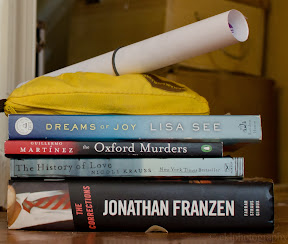
"It never occured to me that the need to catalog the stuff of everyday life might be a sign that the authors I loved were loners and misfits. Normal people, after all, don't stand around at garden parties or lie in bed with their loved ones trying to figure out what even the smallest ordinary gesture means."
-David Samuels, Marginal Notes on the Inner Lives of People with Cluttered Apartments in the East Seventies, a rereading of J.D. Salinger's Franny and Zooey.
Evidence of the superfluity of books in my life: this wee pile was acquired whilst in Sundial Books, currently the best little bookshop in Chincoteague.
Friday, November 25, 2011
Books read in Chincoteague (4 of 7): Boneshaker
 or once, the cover blurb is entirely accurate: "A steampunk-zombie-airship adventure[!]" Really, what more do you need to know? And yet, the characters in Cherie Priest's Boneshaker do go a bit deeper than that. They have emotional needs, frailities, a search for a father and role model, a last hope for lost love, an avoidance of kinship at the same time as a frantic search for the same. Not to mention attempts to understand another culture, come to terms with a violent history and guilt (over the same), and yes, the book contains a map.
or once, the cover blurb is entirely accurate: "A steampunk-zombie-airship adventure[!]" Really, what more do you need to know? And yet, the characters in Cherie Priest's Boneshaker do go a bit deeper than that. They have emotional needs, frailities, a search for a father and role model, a last hope for lost love, an avoidance of kinship at the same time as a frantic search for the same. Not to mention attempts to understand another culture, come to terms with a violent history and guilt (over the same), and yes, the book contains a map. In the desolate wastes of an alternate Seattle it's every man for himself, except when he feels the need to assuage his guilty soul by coming to a comrade's aid, but it's also all men against the undead, the darkness, without and within. Things can be simple and full of comaraderie in a society with a common enemy. And yet, men and women turn against each other in order to save themselves, to avoid or fight their inner demons, always always putting the self first, for there is very little true altruism in the world.
In the desolate wastes of an alternate Seattle it's every man for himself, except when he feels the need to assuage his guilty soul by coming to a comrade's aid, but it's also all men against the undead, the darkness, without and within. Things can be simple and full of comaraderie in a society with a common enemy. And yet, men and women turn against each other in order to save themselves, to avoid or fight their inner demons, always always putting the self first, for there is very little true altruism in the world.The book was pretty good, a fascinating and light frolic through a fledgling universe with some mystery thrown in along the way. The steampunk aspects are not obnoxiously overwhelming, but the "blight" victims (the zombie hordes) seem a little gratuitous (I think this is pretty much always the case with the undead). At four hundred fourteen reasonably dense pages, I could have gone for a lot more detail of the world and development of some of the characters' relationships. I'm told there are further developments to be had in subsequent novels.
Wednesday, November 23, 2011
Books read in Chincoteague (3 of 7): Not Becoming My Mother
 eople of first world countries in the twenty-first century have a tendency to take an awful lot for granted. While many in democratic society worry that their freedoms are shrinking, it also seems as though they are expanding. Even a few decades ago a more conservative U.S. might not have put up with the diatribes of certain "grassroots" movements, more likely dismissing them outright as being incoherent and extremist. Today we still have the great benefit of an equal voice for all, even though some may be less deserving of serious consideration.
eople of first world countries in the twenty-first century have a tendency to take an awful lot for granted. While many in democratic society worry that their freedoms are shrinking, it also seems as though they are expanding. Even a few decades ago a more conservative U.S. might not have put up with the diatribes of certain "grassroots" movements, more likely dismissing them outright as being incoherent and extremist. Today we still have the great benefit of an equal voice for all, even though some may be less deserving of serious consideration.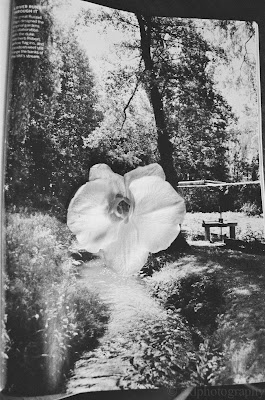 All of which is, for some reason, leading up to my notes on Not Becoming My Mother, this short memoir by Ruth Reichl about her mother's search (somewhat in vain) for a life as a non-homemaker in the middle of the 20th century. I have a certain weakness for reading about the lives of others, who, while not consequential or influential on any grand scale, have at least merited some well-written words and a bit of immortality on the bookshelf. No one is really inconsequential, in the big chaotic world of butterfly wingbeats, but some are significant only to a small circle of fortunate insiders.
All of which is, for some reason, leading up to my notes on Not Becoming My Mother, this short memoir by Ruth Reichl about her mother's search (somewhat in vain) for a life as a non-homemaker in the middle of the 20th century. I have a certain weakness for reading about the lives of others, who, while not consequential or influential on any grand scale, have at least merited some well-written words and a bit of immortality on the bookshelf. No one is really inconsequential, in the big chaotic world of butterfly wingbeats, but some are significant only to a small circle of fortunate insiders. Reichl's search for her mother's story focuses on the the fortunes of mid-century homemakers, facing proud and territorial husbands in a difficult job market after the Depression and World War II. Reichl had originally made the mistake of assuming that everything changed to roses for women after the 19th Amendment was passed. In truth, society took much longer to adjust to the change, and families behind closed doors longer still. Traditional patriarchal values (often maintained by the physically larger and stronger sex, and accepted by women who aren't sure how to do otherwise) still linger today. Reichl's mother did her best to instill deep seated independence and self-reliance in her daughter, such that she might never feel the need to ally herself with a husband in order to get by. Anyway, the thing was inspiring, comforting and entertaining, a quick read. Recommended.
Monday, November 21, 2011
Books read in Chincoteague (2 of 7): Hell to Pay
 his was a bit of a disaster for me. I think I encountered George Pelecanos mentioned among a list of the best DC based authors (including Marie Arana). When I heard he wrote crime novels set in DC, I had to read one. Unfortunately, the first chapter I attempted was not to my liking (I believe that was The Big Blowdown), and I dropped that attempt back at the library in favor of a different set of a characters and plot. Come some booksale, I picked up two more, and brought Hell to Pay along to the beach in hopes that it would be a good fluffy crime/thriller to keep me going.
his was a bit of a disaster for me. I think I encountered George Pelecanos mentioned among a list of the best DC based authors (including Marie Arana). When I heard he wrote crime novels set in DC, I had to read one. Unfortunately, the first chapter I attempted was not to my liking (I believe that was The Big Blowdown), and I dropped that attempt back at the library in favor of a different set of a characters and plot. Come some booksale, I picked up two more, and brought Hell to Pay along to the beach in hopes that it would be a good fluffy crime/thriller to keep me going.Nooo such luck. If I could've gotten behind the writing the story might have been decent, but it seemed bogged down in vernacular (like the books written in a Scottish "accent"), not just in the characters' voices but in the narrator's as well. The overwhelming number of scenes drenched in sexual innuendo and indiscriminate flirtations were nauseating and unappealing and I didn't care in the least whether the crime was solved or not (although at the point I got to, a quarter of the way in, there had yet to _be_ a crime commited). So perhaps this is simply not the book, nor even the author for me. Oh well.
Friday, November 18, 2011
Books read in Chincoteague (1 of 7): Catch-22
 s I finally wrapped up the last chapters of Catch-22 and went to enter this triumph in my book log, I discovered that I had begun this one not just months ago, but last November. Horrors, that I had left a book neglected for so very long, thinking that I wasn't in the mood for it, not giving it a chance. Well, to be fair, I probably wasn't in the mood for it, nor would I ever have been, but finally, on the porch swing overlooking the marsh, I at least felt comfortable enough to forge my way through the latter third of Catch-22 without going crazy myself.
s I finally wrapped up the last chapters of Catch-22 and went to enter this triumph in my book log, I discovered that I had begun this one not just months ago, but last November. Horrors, that I had left a book neglected for so very long, thinking that I wasn't in the mood for it, not giving it a chance. Well, to be fair, I probably wasn't in the mood for it, nor would I ever have been, but finally, on the porch swing overlooking the marsh, I at least felt comfortable enough to forge my way through the latter third of Catch-22 without going crazy myself.Having been told by two reliable sources that this was a hilarious read, full of wit and whimsy, albeit dark whimsy, I figured I ought to at least give it a chance, read the whole damn thing and be able to reflect on it. Having done so, I'm glad I did, but the journey was one of the most depressing I've been on, stretching thin my last shreds of faith in a decent world.
Anyway, horrifyingly obtuse and, yes, hilariously conniving as Colonel Cathcart and Milo are, clearly this is a pretty good book because it did _get to me_. And I did understand Yossarian's plight, the desperation and the confusion, the fear that the world really is nuts, that this must be some deep level of punishing inferno, and the emotional grasping at what few friends could be found in the midst of war.

What spun me for the greatest loop was the ending. I guess I shouldn't say here, (oh, heck: SPOILERS!) but it didn't seem in keeping with the rest of the book. In fact, I was so thrown by the ending that I felt certain I missed an important detail and Yossarian was deep into some fever dream, or was heading off for the promised land. The entire last two chapters or so took a sharp left and nearly tossed this passenger out around the curve. I suppose I'm glad it ended the way it did, with a hope for the future, an open ending and striking out for a new world. All is not lost, life goes on, "persevere."
Not sure the photo is relevant, but since I didn't have anything that really is... this underground catacomb is from an exploration of the old McMillan sand filtration site in NE DC I did with DCUrban Explorers in late October.
This review also appears in part on LibraryThing.
Tags:
1940s,
books,
concepts,
consciousness,
literature,
philosophy,
photo,
psychology,
review,
sarcasm,
WWII
Thursday, November 17, 2011
Books Read in Chincoteague (0 of 7): Introduction
 am a reader. If I could be The Reader I would be, but in this day and age it seems that all of the archetypes have all been claimed, and all one can do is occupy an indefinite article.
am a reader. If I could be The Reader I would be, but in this day and age it seems that all of the archetypes have all been claimed, and all one can do is occupy an indefinite article.
In order to avoid a[nother] rant about [the sad state of] contemporary society, I will simply describe the situation, the setting for the seven posts I will make in the forthcoming fortnight. Once a year, every year for the last [20+] my family has vacationed in a small cottage on Chincoteague Island for a week. When I was smaller and/or younger, the purpose included daily trips to the ocean for sandcastle making and mole-crab catching, mom-made sandwiches and hours spent sitting in the porch swing listening to books on tape.
 Now the entire purpose seems to be to bike around the [nice, flat] island a bit, go for a long walk or two on [what's left of] Assateague Island and spend as much time as possible reading book after [quality] book. In my teens, I blazed through every book Anne McCaffrey had written in the space of approximately 48 hours (Slight exaggeration. May have been 72.). While I'm still not reading Joyce and James and Dostoevsky in the space of hours, I did manage a few decently mature books in the space of a week; a book a day for soothing a soul.
Now the entire purpose seems to be to bike around the [nice, flat] island a bit, go for a long walk or two on [what's left of] Assateague Island and spend as much time as possible reading book after [quality] book. In my teens, I blazed through every book Anne McCaffrey had written in the space of approximately 48 hours (Slight exaggeration. May have been 72.). While I'm still not reading Joyce and James and Dostoevsky in the space of hours, I did manage a few decently mature books in the space of a week; a book a day for soothing a soul.
And, somehow, the books I brought along matched my mental state and future-goals with aplomb. Each stood up and made its point across time and space, reaching me through excellent authors, stories and words.
The overarching themes in a nutshell: From The Shipping News to Catch-22, a frabjous sense of optimism or hopeless-hope in the face of disaster, despair and delirium (Endless tie-in!), lessons on the paths we take through life to the place Ruth Reichl's mom teaches us to be: unshakably within our selves.
Then, from Boneshaker back to Shipping News, a sense of community and grand purpose pervading humanity in times of challenge and need. Reichl's mother proselytizes steadfast self-confidence, but the citizens of Proulx's Newfoundland will tell you: in the end, only the wind and the sea will have their way.
Stay tuned for seven (7!) upcoming (short) book reviews...
Then, from Boneshaker back to Shipping News, a sense of community and grand purpose pervading humanity in times of challenge and need. Reichl's mother proselytizes steadfast self-confidence, but the citizens of Proulx's Newfoundland will tell you: in the end, only the wind and the sea will have their way.
Stay tuned for seven (7!) upcoming (short) book reviews...
Tuesday, November 15, 2011
Photos of phood (now with vastly improved imaging capabilities)
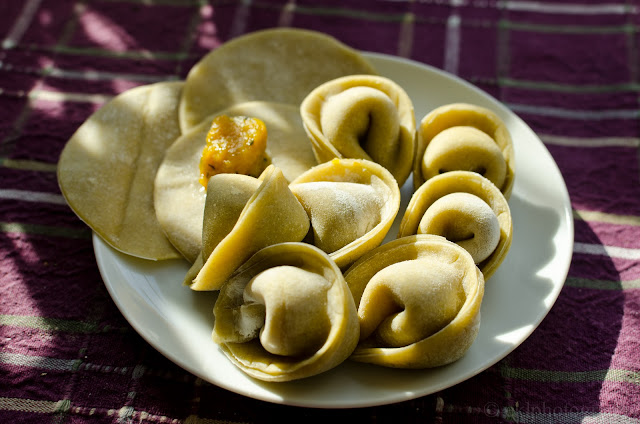
Apparently Mondays are good for making something different. The last time I did tortellini was at least a year ago, but this week I had nabbed a butternut squash at market and have enough eggs to burn on pasta. The squash wasn't terribly flavorful, so wrapping it in pasta seemed like a good plan. The photo shows some unrolled pasta circles, a bit of filling (squash + whatever herbs were lying around) and a few of the finished tortellinis. Cheese is really fantastic in these, but squash is a heckuva lot cheaper. They come out pretty big because I can only roll the pasta so thin with a rolling pin, and any less filling isn't sufficient.
I wont write out the entire process, but the pasta recipe is basically: for each egg, use a bit less than 100g of flour. I used 5 eggs and maybe 450g flour to start, a bit more for rolling, which makes for a very soft pasta dough, but is so much easier to work with.
The method: make a pile of flour with a well, put eggs in the middle, slowly stir flour in from edges until everything is integrated enough to knead (and not run off the counter). Knead. Let rest, covered. Divide, roll out to 1/4" thick slabs. Rest covered. Roll out as thin as you like, dry on a rack to slightly leathery feel. Cut. Dry some more if just doing noodles or stuff with stuff and let dry a bit. Freeze if not using right away, drop (fresh or frozen) in boiling water for ~5 min (mine, as I said, are very thick). Tada.
Tags:
Alexandria VA,
chocolate,
cooking,
culture,
Farm Market,
food,
food snobbery,
photo,
recipe,
vegetarian
Monday, November 7, 2011
Palmiers
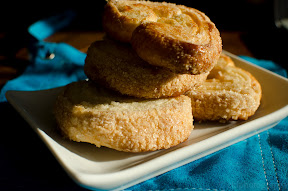

Last week I got one of the most ironic phone calls I can remember receiving. It was my dental hygienist, calling to remind me of my appointment... and to ask me if I might bring baked goods. So, last night, at a loss for what to make, I tried pastry for the first time. These are palmiers, and are made exclusively with flour, butter, water, salt and sugar. Even the dentist himself agreed that they were fantastic.
Monday, October 17, 2011
Pear, almond cream, tart. At length.
ometimes the route I take to a baking project is long and roundabout. In this case, I started well over a month ago thinking "oh hey, I should make pie crust with all this cream cheese that came out of my parents' fridge during the hurricane." Having subsequently moved, still with said cream cheese, it's now October, and the fruit available has changed completely. Fortunately, I moved to a location two blocks from a weekly, year-round farm market and despite the apple season fanatics, I found some lovely pears and bought 10.
Then I went looking for a recipe. I'd do it first, but that tends to result in a harried and expensive trip to several specialty stores looking for things like "espresso powder" and whatever. In this case, I got away with nothing more extravagant than a vanilla bean (albeit a bit of a ripoff at the local "My Organic Market").
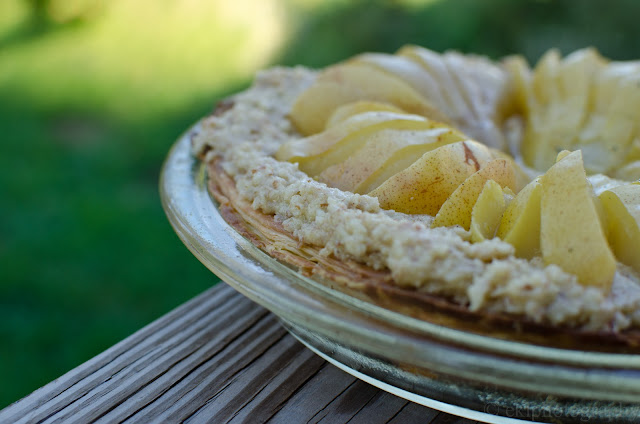
So there I was with pears and cream cheese pie crust premade and waiting in the freezer (keeps for up to three months, yet I never pre-make enough for it to last more than one pie). A quick poke through my trusty bookshelf o' cookbooks, and I arrived at the inevitable conclusion: The Pie and Pastry Bible. Someday, I swear I'll use different books. Really. Having avoided apples especially because I'm tired of fruit-in-crust pies, I wanted something a little more interesting. The options were a gingery pear chiffon pie (which I had modified a couple years ago into a ginger and chocolate ganache pie for Thanksgiving) or pear almond cream tart.
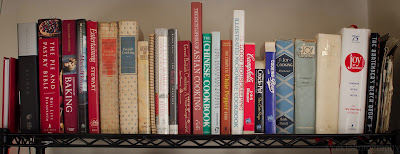
Before I get into the things I'll do differently next time, let me just say that this is a very tasty, decent looking little open-faced pie/tart. However.
It started with the pre-baked crust. Ok, so the recipe called for the normal flakey pie crust, in a tart pan, and I was using cream cheese crust in a pie plate. It kinda shrunk a lot and got a bit too toasty on its own when it should have been a little underbaked in order to withstand the subsequent baking with filling. Still, super flakey, and actually incredibly tasty when dark brown and slightly caramelized with filling.
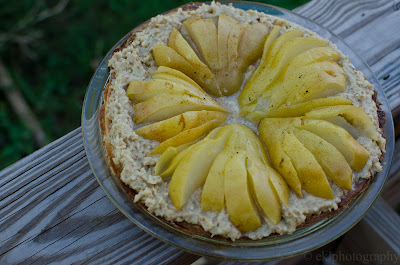
I also neglected to thoroughly process the almond flour/stuff. And to use blanched, sliced almonds. But that's just cause they come in "raw" in the bulk department. So, instead of what I assume was meant to be a smooth, creamy filling, I have a nutty, thick filling. It did manage to puff up (eventually) and has the texture of chewy meringue around the edges (also a little darker than necessary).
The poaching of the pears went well, though I recommend watching them a bit more carefully than I did and not getting distracted by other wildly exciting things like de-clogging the vacuum. yeah. I reserved some of the poaching liquid for my food and drink obsessed housemate to mix cocktails or something with. The vanilla bean was very worth it and can never, ever be substituted with vanilla extract, so don't even think about it.

In the video on Rose Levy Beranbaum's website (below), she has the pears sliced the short way across and fanned into little ridged mountains in the almond filling. It makes a kind of star pattern, but that didn't quite make sense to me visually, edibly or uh, logistically, so I fanned them lengthwise instead, with the intent that the almond filling could puff up between the slices. This mostly worked, but again I neglected to really thoroughly drain the pears, so the pie/tart took a lot longer to cook and was too wet in the center for most of the time.
This is kind of a long post for one little pie experiment, but I went searching the interweb for more info when the recipe didn't make sense and only easily found RLB's website. Hopefully this will help someone else. And also photos. It's blissful having a back porch to take things out on into natural light in order to photograph. The finished pie photo is from inside and at night (bleh!).
Then I went looking for a recipe. I'd do it first, but that tends to result in a harried and expensive trip to several specialty stores looking for things like "espresso powder" and whatever. In this case, I got away with nothing more extravagant than a vanilla bean (albeit a bit of a ripoff at the local "My Organic Market").

So there I was with pears and cream cheese pie crust premade and waiting in the freezer (keeps for up to three months, yet I never pre-make enough for it to last more than one pie). A quick poke through my trusty bookshelf o' cookbooks, and I arrived at the inevitable conclusion: The Pie and Pastry Bible. Someday, I swear I'll use different books. Really. Having avoided apples especially because I'm tired of fruit-in-crust pies, I wanted something a little more interesting. The options were a gingery pear chiffon pie (which I had modified a couple years ago into a ginger and chocolate ganache pie for Thanksgiving) or pear almond cream tart.

Before I get into the things I'll do differently next time, let me just say that this is a very tasty, decent looking little open-faced pie/tart. However.
It started with the pre-baked crust. Ok, so the recipe called for the normal flakey pie crust, in a tart pan, and I was using cream cheese crust in a pie plate. It kinda shrunk a lot and got a bit too toasty on its own when it should have been a little underbaked in order to withstand the subsequent baking with filling. Still, super flakey, and actually incredibly tasty when dark brown and slightly caramelized with filling.

I also neglected to thoroughly process the almond flour/stuff. And to use blanched, sliced almonds. But that's just cause they come in "raw" in the bulk department. So, instead of what I assume was meant to be a smooth, creamy filling, I have a nutty, thick filling. It did manage to puff up (eventually) and has the texture of chewy meringue around the edges (also a little darker than necessary).
The poaching of the pears went well, though I recommend watching them a bit more carefully than I did and not getting distracted by other wildly exciting things like de-clogging the vacuum. yeah. I reserved some of the poaching liquid for my food and drink obsessed housemate to mix cocktails or something with. The vanilla bean was very worth it and can never, ever be substituted with vanilla extract, so don't even think about it.

In the video on Rose Levy Beranbaum's website (below), she has the pears sliced the short way across and fanned into little ridged mountains in the almond filling. It makes a kind of star pattern, but that didn't quite make sense to me visually, edibly or uh, logistically, so I fanned them lengthwise instead, with the intent that the almond filling could puff up between the slices. This mostly worked, but again I neglected to really thoroughly drain the pears, so the pie/tart took a lot longer to cook and was too wet in the center for most of the time.
This is kind of a long post for one little pie experiment, but I went searching the interweb for more info when the recipe didn't make sense and only easily found RLB's website. Hopefully this will help someone else. And also photos. It's blissful having a back porch to take things out on into natural light in order to photograph. The finished pie photo is from inside and at night (bleh!).
Monday, September 12, 2011
Another ode to bicycling
 here must be a storm out at sea, on the bay, over bigger water. The field at Gravelly Point is speckled with seagulls, round white spots on the lush green (it's already been raining)(like golf balls). A single gull hovers in the wind over the trail, bored with picking through the grass. Every once in a while one of them cries out, that sound that puts me on the beach, on sand, in salt breeze. The roaring silence of wind in my ears is harshly broken by the roaring noise of jet engines overhead, a larger bird taking off, banking against the wind. Some of the gulls startle and scatter into the air en masse to land a few feet away. False start. A lone jogger jogs by, similarly startled to find this place so differently populated. Il n'y a pas des gens aujourd'hui, seulement les mouettes et le vent.
here must be a storm out at sea, on the bay, over bigger water. The field at Gravelly Point is speckled with seagulls, round white spots on the lush green (it's already been raining)(like golf balls). A single gull hovers in the wind over the trail, bored with picking through the grass. Every once in a while one of them cries out, that sound that puts me on the beach, on sand, in salt breeze. The roaring silence of wind in my ears is harshly broken by the roaring noise of jet engines overhead, a larger bird taking off, banking against the wind. Some of the gulls startle and scatter into the air en masse to land a few feet away. False start. A lone jogger jogs by, similarly startled to find this place so differently populated. Il n'y a pas des gens aujourd'hui, seulement les mouettes et le vent.
Tags:
bicycling,
consciousness,
environment,
flying,
French,
nature,
not NaNoWriMo,
philosophy,
photo,
poetry,
travel,
Washington DC,
writing
Tuesday, July 19, 2011
Wineberry pie
aving the recipe is only half the battle. It took several pies for me to get the pie crust to behave in such a way that I could roll it out, instead of trying to piece something together out of the fragments that never became a whole. Your only hope in this matter is to start with a good recipe and figure it out for yourself. The very best book ever is "The Pie and Pastry Bible" by Rose Levy Beranbaum. I've gotten so many recipes out of this book, if you know me, you've probably had one. In my mind, the best kind of cookbook isn't just recipes but philosophy and information, so that you actually have some clue why things need to be just so. Absolutely essential for the baker. Go get it. shoo.
This past weekend I had the good fortune to spend a night atop a mountain in the Shenandoah region, and came back (thanks to Wortklauberlein) with a pound of fresh berries from the bazillions of vines lining the roads. The local population informed us that they are wineberries, a particularly sweet variety of raspberry. There's nothing so satisfying as baking or cooking with food you've picked yourself. er, or that someone has thoughtfully picked for you.

Ingredients
"Deluxe flaky pie crust" 21 oz
14 tbl unsalted butter, cold.
2.25 cups flour (pref. pastry)
1/4 tsp salt
1/4 tsp baking powder
7.5 tbl ice water
1 tbl cider vinegar
0.5 cup sugar (I only had brown)
2.5 tbl cornstarch
pinch salt
1 lb berries, washed and picked over for passengers.
This past weekend I had the good fortune to spend a night atop a mountain in the Shenandoah region, and came back (thanks to Wortklauberlein) with a pound of fresh berries from the bazillions of vines lining the roads. The local population informed us that they are wineberries, a particularly sweet variety of raspberry. There's nothing so satisfying as baking or cooking with food you've picked yourself. er, or that someone has thoughtfully picked for you.

Ingredients
"Deluxe flaky pie crust" 21 oz
14 tbl unsalted butter, cold.
2.25 cups flour (pref. pastry)
1/4 tsp salt
1/4 tsp baking powder
7.5 tbl ice water
1 tbl cider vinegar
0.5 cup sugar (I only had brown)
2.5 tbl cornstarch
pinch salt
1 lb berries, washed and picked over for passengers.
- Pick a pound of wineberries and a few blackberries from Flattop Mountain. Or your backyard. Or somebody else's backyard. I don't think you can buy wineberries in the store, but this recipe will likely work with whatever berries you have handy.
- Make pie crust:
- cut butter into small cubes, freeze for 30 min +
- put flour, salt, baking powder in gallon size ziplock bag, shake to mix thoroughly.
- add frozen butter, expel air and use rolling pin to (patiently) roll butter into flat flakes. Shake bag to redistribute when mix gets bunched up at one end. Freeze for 10 min.
- sprinkle water and vinegar into bag, toss to mix.
- keeping the bag open, knead from the outside of the bag until dough forms a single lump. To do this, you'll need to use the bag to fold the dough onto itself (don't touch it directly). About halfway through you'll get frustrated because it's not holding together yet. Put it in the fridge for a few minutes and come back to it. Once it's a lump, divide into two pieces, one for the top and one for the bottom crust.
- Refrigerate for at least an hour, preferably overnight.
- Roll out bottom crust on lightly floured surface to 1/8 inch thickness. Lay in pie pan, cover and refrigerate at least 30 min, no more than 3 hours.
- Combine sugar, cornstarch and salt, whisk together. Toss berries gently in this mixture and let sit for 15 minutes.
- Toss gently again and pour into bottom crust.
- Roll out top crust to 1/8 inch. I used a lattice pattern, but you could do a full top crust and cut a hole in the middle for steam to escape. Lay top crust over berries, use water to glue and fold edges under (or over) and crimp using a fork or your fingers.
- Refrigerate pie, covered loosely in plastic wrap, for about an hour.
- Preheat oven to 425 at least 20 minutes before baking. Use a baking stone if you have one and put it on the lower rack. Bake pie for 30 minutes or until juices are bubbling and crust is browned. Put a baking sheet or foil underneath the pie plate to catch drips.
- Let cool for at least 2 hours before serving, probably more like 4 if you have the patience.
Tags:
Appalachians,
baking,
books,
dessert,
food,
pie,
recipe,
Shenandoah
Wednesday, July 6, 2011
Mini reviews: Etiquette and conversation, or, "An echo is sufficient"
any of the books I looked through in search of advice on how to be a good conversationalist made the same points: remember that you are conversing with someone, not interrogating or soliloquizing. What I'm looking for is how to ask good questions, what topics to bring up and just what to say in general. Many sources point out the usual topics: weather, travel, news, even the forbidden politics and religion, and strongly recommend against talking about yourself. The easiest way to remember this is to avoid using "I" and "Me" as much as possible. It can be tricky at first and often leads to getting even more tongue tied, but making conversation or writing without the dreaded personal pronouns is an entertaining challenge.
Emily Post's Etiquette- Etiquette focuses on how to be polite and interact appropriately in any situation. The seminal work on traditional etiquette is perhaps my favourite reference out of all that I read through because it takes a more conservative view of manners and proper conduct. Sadly, the young men whom I ran some of Post's points past were more of the opinion that the "liberated woman" doesn't need the door held, her dinner paid for, or any sort of special consideration. She is equal, therefore she is one of of the guys! Mais non, the liberated woman just doesn't want to do all the damn dishes herself. Again.
Grace Under Pressure- This is the book of tactics for those situations you'd never admit to being in. Pulling your reputation back together after a mishap at the company party, getting by at an ex's wedding, and generally how to be gracious and sensitive no matter what. On conversation: a good section on how to start conversations, balancing questions and responses, listening (which makes all the difference when it comes time to reply), getting out of bad small talk, insults, and introducing yourself to strangers. Comes with entertaining anecdotes and scandal (clearly the selling point: this would never be me!).
21st Century Etiquette- Frankly, don't bother with this one. Outdated references to electronic mail and chatrooms, "teens" as children, slightly condescending "quizzes" at the ends of chapters and generally a bit simplistic. And there wasn't much on conversation.
What do you say when...- More quizzes. I suppose this is a style, as if it were a workbook, but I don't love it. Also a more traditional viewpoint with some good thoughts, and short, so a quick read. There's a good section on romantic meetings that also applies to platonic interactions and meeting new people. Worth it because the book is dedicated to conversation.
The Art of Mingling- Finally, we get past some of the more clichéd approaches (Haven't I seen you somewhere before?) to ideas on how to continue the conversation. Some of the ideas will sound pretty awkward ("This party is a virtual utopia" comes from the a-z list of words to build from when at a loss), but there are plenty such as watching from afar with another wall flower, asking a group a random question to poll responses and start a debate and so on. Kind of dorky to be seen with, but essentially quite useful.
Conversation: A History of a Declining Art- Certainly this is the most expansive and in-depth of all those I checked out... which unfortunately means I did not have time to read it in its entirety. However, I can say that having skimmed a bit, it looks to be perhaps more useful than any of the aforementioned because not only does it include methods from historical conversationalists (hello, Socrates?), but it's actually worth talking about the subject matter when you're done. Will take this one out later to read in full.
Then we come to The Art of Conversation and The Art of Civilized Conversation. Different authors and publishers, but you can just see the expression on the face of the former when she discovered the latter. These are both dense, full of lists, do's and dont's and bullets. The first, however, has the following passage:
Thanks to the Arlington VA public library for having all these books and putting them on hold for me.
Emily Post's Etiquette- Etiquette focuses on how to be polite and interact appropriately in any situation. The seminal work on traditional etiquette is perhaps my favourite reference out of all that I read through because it takes a more conservative view of manners and proper conduct. Sadly, the young men whom I ran some of Post's points past were more of the opinion that the "liberated woman" doesn't need the door held, her dinner paid for, or any sort of special consideration. She is equal, therefore she is one of of the guys! Mais non, the liberated woman just doesn't want to do all the damn dishes herself. Again.
Grace Under Pressure- This is the book of tactics for those situations you'd never admit to being in. Pulling your reputation back together after a mishap at the company party, getting by at an ex's wedding, and generally how to be gracious and sensitive no matter what. On conversation: a good section on how to start conversations, balancing questions and responses, listening (which makes all the difference when it comes time to reply), getting out of bad small talk, insults, and introducing yourself to strangers. Comes with entertaining anecdotes and scandal (clearly the selling point: this would never be me!).
21st Century Etiquette- Frankly, don't bother with this one. Outdated references to electronic mail and chatrooms, "teens" as children, slightly condescending "quizzes" at the ends of chapters and generally a bit simplistic. And there wasn't much on conversation.
What do you say when...- More quizzes. I suppose this is a style, as if it were a workbook, but I don't love it. Also a more traditional viewpoint with some good thoughts, and short, so a quick read. There's a good section on romantic meetings that also applies to platonic interactions and meeting new people. Worth it because the book is dedicated to conversation.
The Art of Mingling- Finally, we get past some of the more clichéd approaches (Haven't I seen you somewhere before?) to ideas on how to continue the conversation. Some of the ideas will sound pretty awkward ("This party is a virtual utopia" comes from the a-z list of words to build from when at a loss), but there are plenty such as watching from afar with another wall flower, asking a group a random question to poll responses and start a debate and so on. Kind of dorky to be seen with, but essentially quite useful.
Conversation: A History of a Declining Art- Certainly this is the most expansive and in-depth of all those I checked out... which unfortunately means I did not have time to read it in its entirety. However, I can say that having skimmed a bit, it looks to be perhaps more useful than any of the aforementioned because not only does it include methods from historical conversationalists (hello, Socrates?), but it's actually worth talking about the subject matter when you're done. Will take this one out later to read in full.
Then we come to The Art of Conversation and The Art of Civilized Conversation. Different authors and publishers, but you can just see the expression on the face of the former when she discovered the latter. These are both dense, full of lists, do's and dont's and bullets. The first, however, has the following passage:
"In the 1960s... computer pioneer Joseph Weizenbaum created Doctor, a software program that adapted a psychotherapy technique for bouncing back patients' statements as questions:
User: I have been rather depressed lately.One morning he was appalled to discover his transfixed secretary at a computer, unspooling her sorrows into Doctor's clunky, copycat code. ...So the thought that an echo is sufficient to convince us we're being listened to, that the bogus Doctor could seduce the secretary, carries the degrading suggestion that much of human complexity—those worries and wonders we store up and long to share—may also be illusory, empty, and that we are mere bundles of reactions, mysterious and meaningful only to us."
Computer: Are you depressed often?
User: Yes, almost all the time.
Computer: Why do you say yes almost all the time?
User: Right now I feel like I could cry.
Computer: Is it because right now you feel like you could cry that you came to me?
Thanks to the Arlington VA public library for having all these books and putting them on hold for me.
Tags:
advice to myself,
books,
computer,
etiquette,
manners,
philosophy,
review
Subscribe to:
Posts (Atom)













